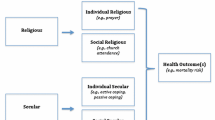Abstract
The purpose of this study was to learn more about the role of religious beliefs and practices in bereavement. Subjects were 312 adults each bereaved approximately one year. They were interviewed at the rate of about 50 per year over a 6 year period. Conclusions include: a) The opportunity to say “goodbye” to the deceased was significantly related to positive coping and outlook; (b) 47% of our subjects reported contact with the deceased following the death but such contact was not related to coping or outlook; c) grieving people are much more likely to turn to women than men for help; d) 77% said their religious beliefs were of considerable help in their grief.
Similar content being viewed by others
References
Aiken, L. (1994).Dying, death and bereavement Massachusetts: Allyn and Bacon.
Balk, D. (1991). Sibling death, adolescent bereavement, and religion.Death Studies, 15, 1–20.
Bolton, C., & Camp, D. (1989) The post-funeral ritual in bereavement counseling and grief work.Journal of Gerontological Social Work, 13(3/4) 49–59.
Cameron, E. (1991). Creative ritual: Bridge between mastery and meaning.Pastoral Psychology, 40(1), 3–13.
Dean, P. (1995). Is death education a “nasty little secret”? A call to break the alleged silence. In L. DeSpelder & A. Strickland (Eds.),The path ahead: Readings in death and dying. (pp. 322–326). California: Mayfield Publishing Company.
DeSpelder, L., & Strickland, A. (1992).The last dance: Encountering death and dying. California: Mayfield Publishing Company.
Dewey, D. (1988). When a congregation cares: Organizing ministry to the bereaved.Death Studies, 12, 123–135.
Edmonds, S., & Hooker, S. (1992). Perceived changes in life meaning following bereavement.Omega, 25(4), 307–318.
Eisenbruch, M. (1990, December). The cultural bereavement interview: A new clinical research approach for refugees.Psychiatric Clinics of North America, 13(4), 715–735.
Fickling, K. (1993, Fall). Stillborn studies: Ministering to bereaved parents.The Journal of Pastoral Care, 47(3), 217–227, Fall.
Filkins, K. (1993, Fall). Stories for those who mourn: Personal memories can salve death's sting.Leadership, 14, 68–69, Fall.
Gilbert, K. (1992, Spring). Religion as a source for bereaved parents.Journal of Religion and Health 31(1), 19–30, Spring, 1992.
Hill, E., & Chase, C. (1992, Fall). The resurgence of the erotic in the context of loss: Implications for pastoral counseling.The Journal of Pastoral Care, 46(3), 237–245.
Kalu, W. (1990). Bereavement and stress in career women.Women & Therapy, 10(3), 75–87.
Kavanagh, D. (1990). Towards a cognitive-behavioral intervention for adult grief reactions.British Journal of Psychiatry, 157, 373–383.
Lerner, M. (1984). When, why and where people die. In E. Schneidman (Ed.), Death:Current perspectives. (pp. 40–59). California: Mayfield Publishing Company.
Mattlin, J., Wethington, E., & Kessler, R. (1990, March). Situational determinants of coping and coping effectiveness.Journal of Health and Social Behavior, 31, 103–122. March.
Meyer, C. (1991, May). Church after death.The Witness, 74, 20–21.
Parachin, V. (1991, May). How to survive the sorrow of suicide.The Witness, 74, 22–24, May.
Powers, L., & Wampold, B. (1994). Cognitive-behavioral factors in adjustment to adult bereavement.Death Studies, 18, 1–24.
Ritter, H. (1993, Winter). Perspectives on thanatology: Moving from theory to practice—or, is death a bad idea?The Journal of Pastoral Care, 47, 428–431, Winter.
Rosik, C. (1989). The impact of religious orientation in conjugal bereavement among older adults.International Journal of Aging and Development, 28(4), 251–260.
Russell, B. (1995). Do we survive death? In J. Williamson & E. Schneidman (Eds.).,Death: Current perspectives, (pp. 450–453). California: Mayfield Publishing Company.
Schaefer, D., & Lyons, C. (1988).How do we tell the children? Helping children understand and cope when someone dies. New York: Newmarket Press.
Sherkat, D., & Reed, M. (1992). The effects of religion and social support on self-esteem and depression among the suddenly bereaved.Social Indicators Research, 26, 259–275.
Toynbee, A. (1984). The relation between life and death. In E. Schneidman (Ed.),Death: Current perspectives, (pp. 8–14). California: Mayfield Publishing Company.
VanKatwyk, P. (1993, Summer). A family observed: Theological and family systems perspectives on the grief experience.The Journal of Pastoral Care, 47(2), 141–147.
Wassner, W. (1991). The pastoral dynamics of miscarriage.Pastoral Psychology, 40(2), 113–121.
Wikan, U. (1988). Bereavement and loss in two Muslim communities: Egypt and Bali compared.Social Science & Medicine, 27(5), 451–460.
Author information
Authors and Affiliations
Rights and permissions
About this article
Cite this article
Frantz, T.T., Trolley, B.C. & Johll, M.P. Religious aspects of bereavement. Pastoral Psychol 44, 151–163 (1996). https://doi.org/10.1007/BF02251401
Issue Date:
DOI: https://doi.org/10.1007/BF02251401



